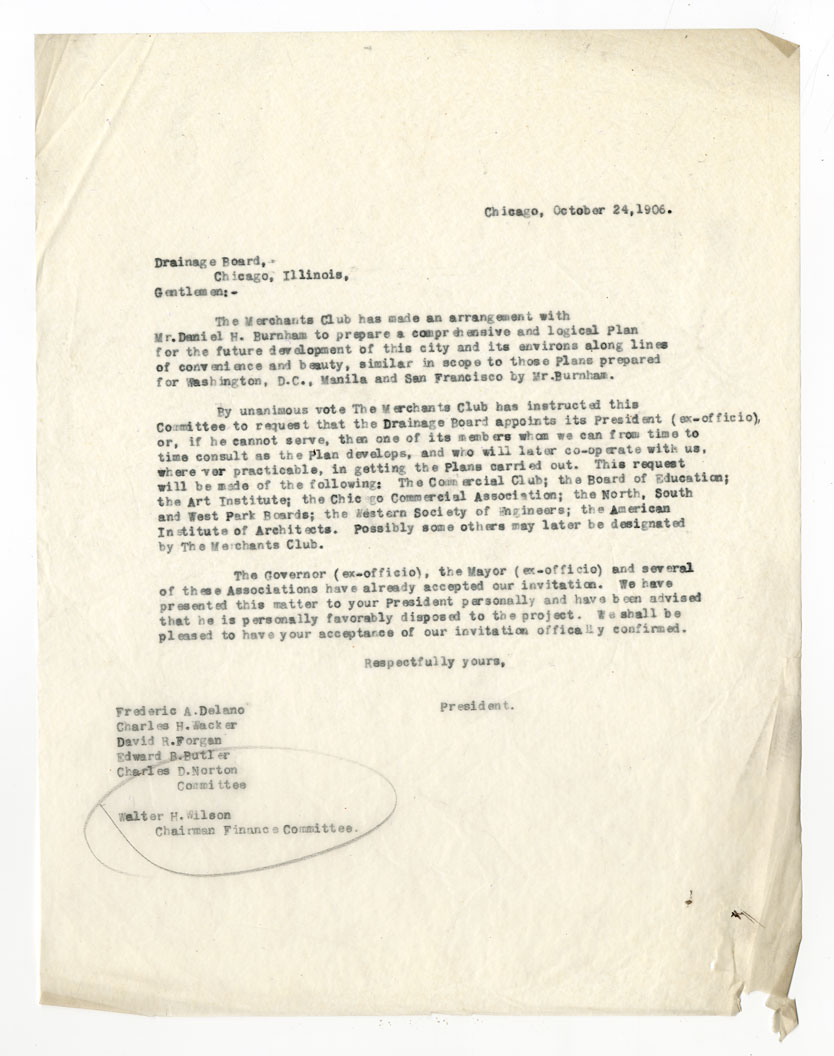 |
TITLE:
DATE:
SUMMARY:
PDF:
|
Charles D. Norton to Drainage Board
10/24/1906
The planning committee involved prominent Chicago businesses, agencies, and institutions from an early date. This letter requests that the Drainage Board assign a representative to provide periodic input into the Plan, and it explains that the Club has also reached out to the Art Institute, the Board of Education, Park Boards, and various other groups.
DOWNLOAD this document. (1 page)
|
 |
TITLE:
DATE:
SUMMARY:
PDF:
|
Chancey S. Millard to Daniel H. Burnham
10/27/1906
Burnham received many letters—both solicited and unsolicited—from individuals with an interest in the Plan and its potential scope. In this letter, which includes a hand-drawn map, an Irving Park resident urges Burnham to consider the role and impact of the Chicago River, "this only bit of natural scenery within our borders."
DOWNLOAD this document. (3 pages)
|
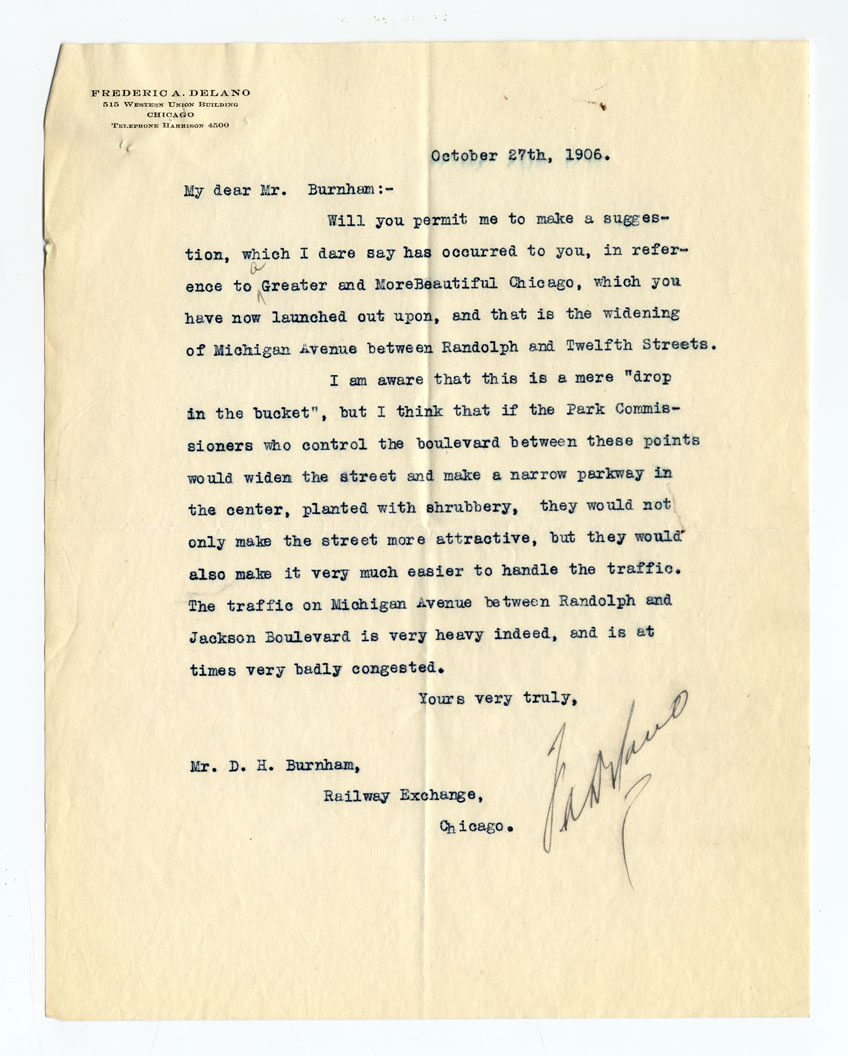 |
TITLE:
DATE:
SUMMARY:
PDF:
|
Frederic A. Delano to Daniel H. Burnham
10/27/1906
Committee members frequently discussed their ideas for improving Chicago, based on their own experiences living and working in the city and depending on their professional areas of expertise. Here, Frederic Delano alerts Burnham to an area of high traffic and suggests the widening of Michigan Avenue—a recommendation that would be a key component of the completed Plan.
DOWNLOAD this document. (1 page)
|
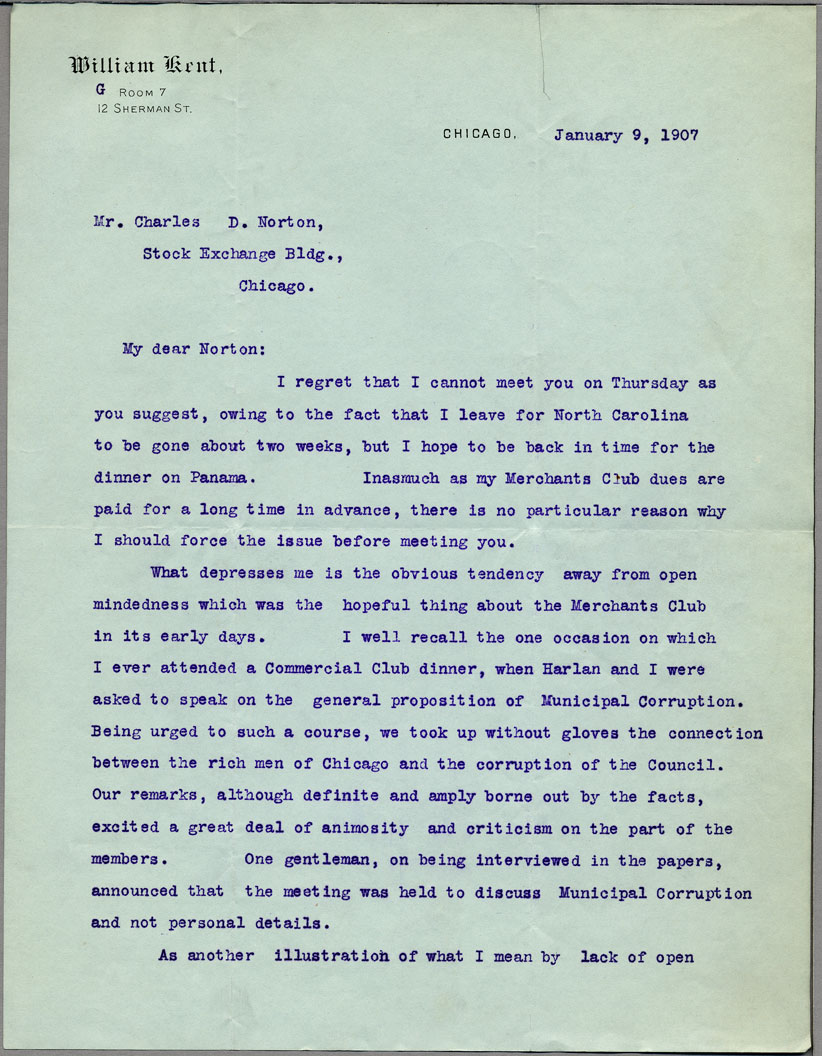 |
TITLE:
DATE:
SUMMARY:
PDF:
|
William Kent to Charles D. Norton
01/09/1907
In this letter, Merchants Club member William Kent criticizes the increasing reluctance of the Club to confront class issues and city corruption. His concern extends to the Club's membership policy, which he says appears to favor financial success over citizenship. His comments, unusual among this body of correspondence, presage the primary criticism of the Plan of Chicago: its failure to address underlying problems of class differences and poverty.
DOWNLOAD this document. (2 pages)
|
 |
TITLE:
DATE:
SUMMARY:
PDF:
|
"South Sider," to Daniel H. Burnham
01/19/1907
This anonymous "South Sider" recommends construction of a continuous boulevard along the lake, essentially recapitulating Burnham's proposed lakefront plans of 1896 and anticipating the similar recommendations in the Plan of Chicago. The South Sider contends that if the lakefront is opened to the people, "we should then have the most beautiful city in the world."
DOWNLOAD this document. (1 page)
|
 |
TITLE:
DATE:
SUMMARY:
PDF:
|
G.E.M. Pratt to Charles D. Norton
01/26/1907
Several businessmen impressed on the Committee the importance of Chicago's commercial interests. Some feared that efforts to beautify the city would conflict with or preclude the commercial use of land and harbors. In this letter, G.E.M. Pratt contends, "I am in favor of a city beautiful...but the commerce & navigation of our city by law come first."
DOWNLOAD this document. (4 pages)
|
 |
TITLE:
DATE:
SUMMARY:
PDF:
|
Olmsted Brothers Landscape Architects, to Daniel H. Burnham
02/08/1907
In addition to drawing from his own planning experience, Burnham gathered city planning reports and documentation from a number of American and European cities. This letter from the Olmsted Brothers, landscape architects in Massachusetts, suggests several sources of information for civic improvement projects. Notations on the letter suggest that Burnham or Bennett followed up on those recommendations.
DOWNLOAD this document. (1 page)
|
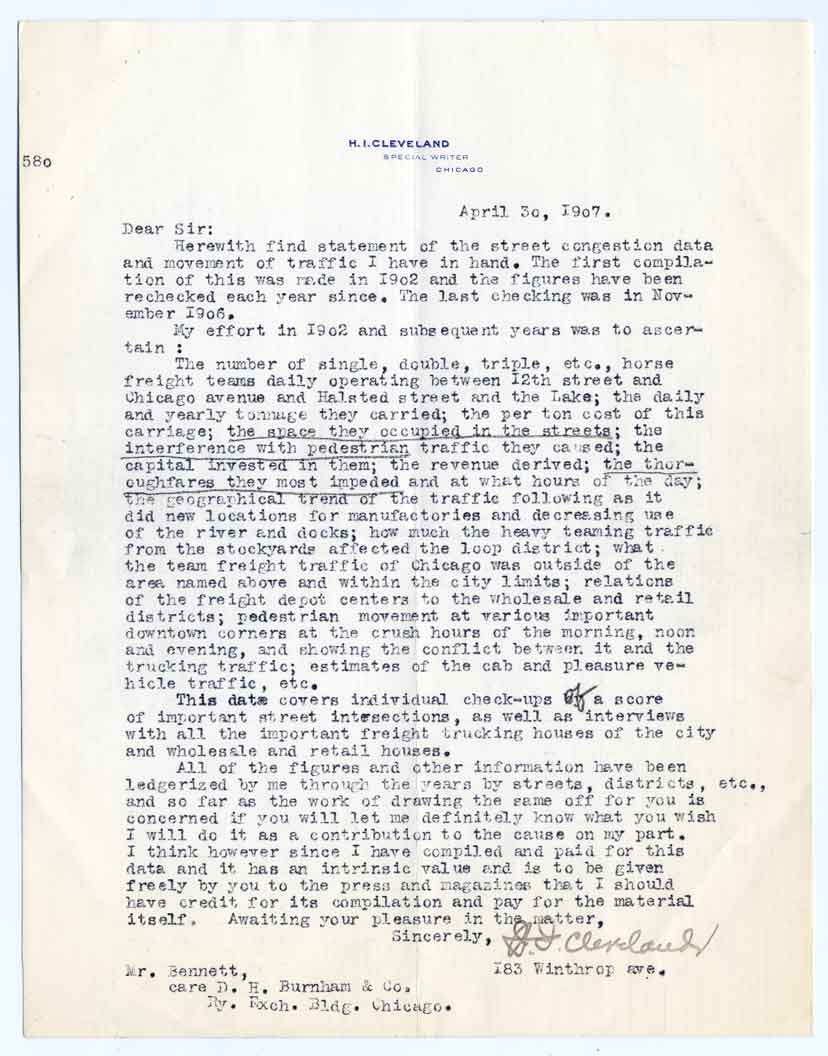 |
TITLE:
DATE:
SUMMARY:
PDF:
|
H.I. Cleveland to Edward H. Bennett
04/30/1907
Burnham and Bennett requested from several sources hard data on population, traffic, and movement throughout the City of Chicago. Here, statistician H.I. Cleveland describes the many figures he has compiled, including freight traffic and pedestrian patterns at various intersections and areas.
DOWNLOAD this document. (1 page)
|
 |
TITLE:
DATE:
SUMMARY:
PDF:
|
W.H. Bixby to Frederic A. Delano
12/03/1907
The Committee was aware of the need to shape the Plan in accordance with state and federal laws. Lieutenant Colonel W.H. Bixby of the United States Corps of Engineers helped explain the legal ramifications of various plans, especially with respect to the outer harbor. In this letter, he suggests the committee take early steps to pass a statue that would allow commercial use of any Illinois State waterfront.
DOWNLOAD this document. (2 pages)
|
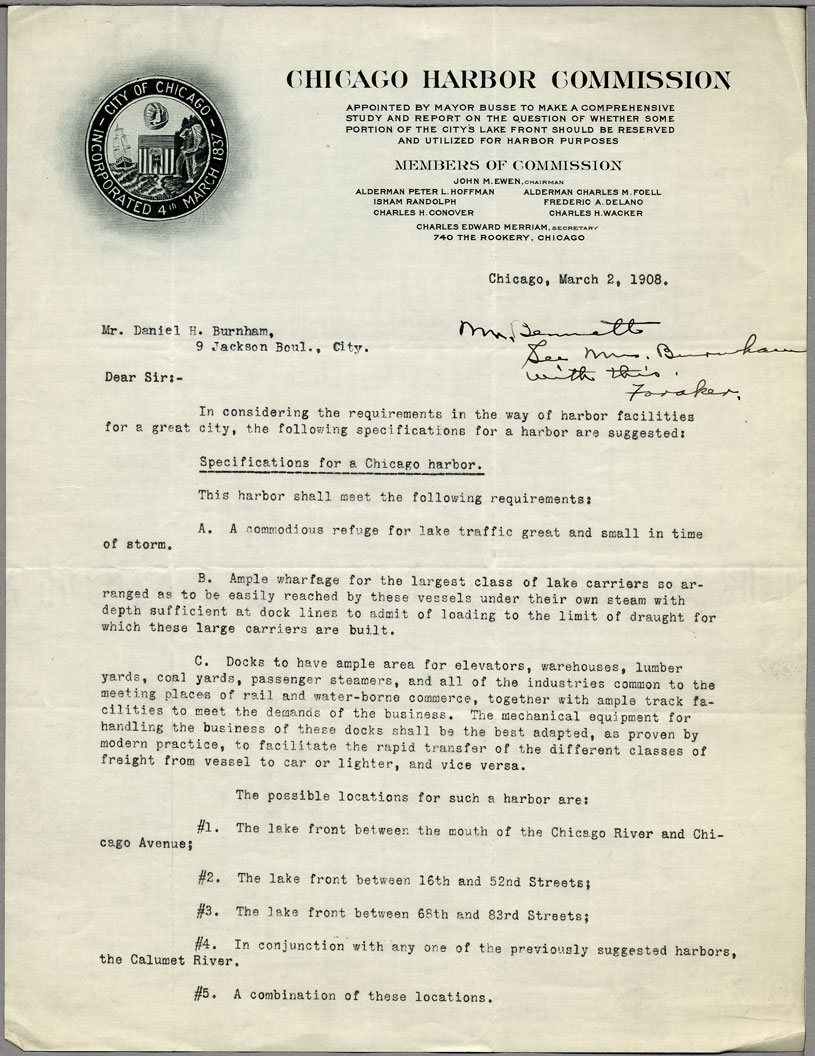 |
TITLE:
DATE:
SUMMARY:
PDF:
|
Charles E. Merriam to Daniel H. Burnham
03/02/1908
The Commercial Club was not alone in its efforts to plan for the future of Chicago; several other groups and councils formed to address areas they thought in need of improvement. The Chicago Harbor Commission was instated by the Mayor and included both Frederic Delano and Charles Wacker. In this letter, the Commission supplies its recommended specifications for a harbor and asks Burnham to submit his own ideas.
DOWNLOAD this document. (2 pages)
|
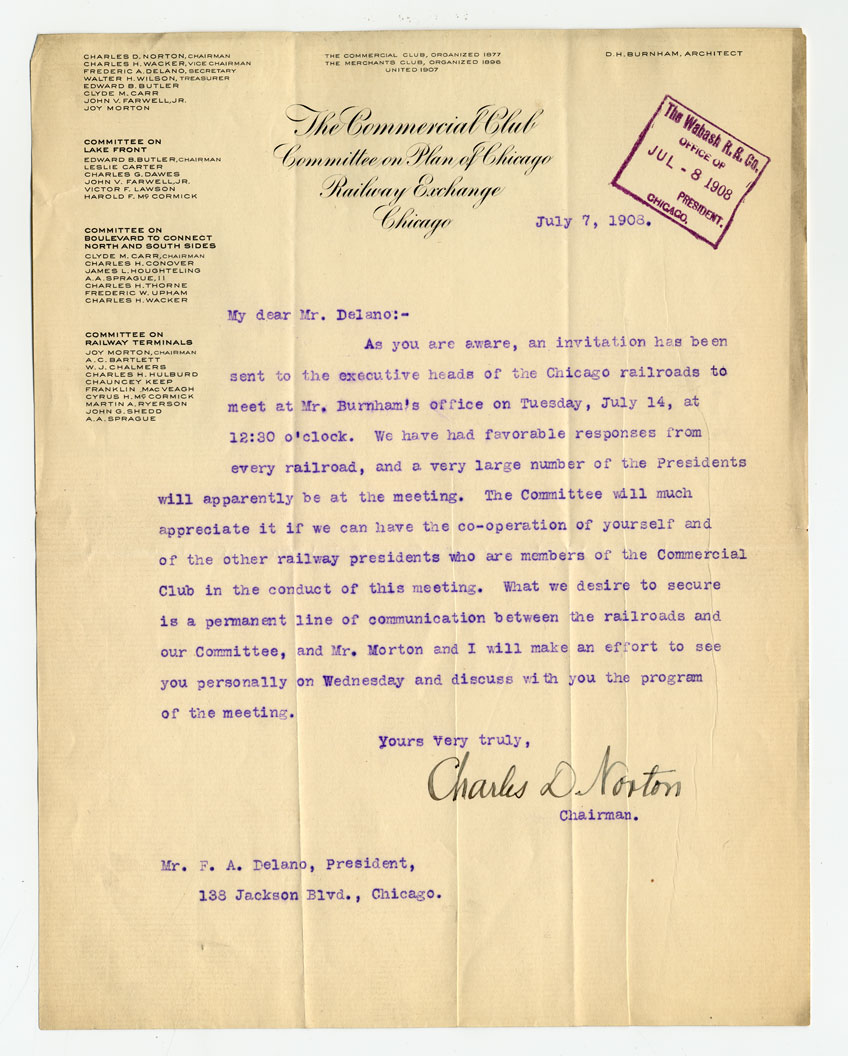 |
TITLE:
DATE:
SUMMARY:
PDF:
|
Charles D. Norton to Frederic A. Delano
07/07/1908
The committee recognized the importance of wooing railroad companies and involving them in the planning process. For months, committee members worked to open lines of communication with railroad executives, an effort they hoped would culminate in an important meeting on July 14, 1908. Here, Norton urges Delano and other railway presidents who are members of the Commercial Club to rally support and present a unified front at the meeting.
DOWNLOAD this document. (1 page)
|
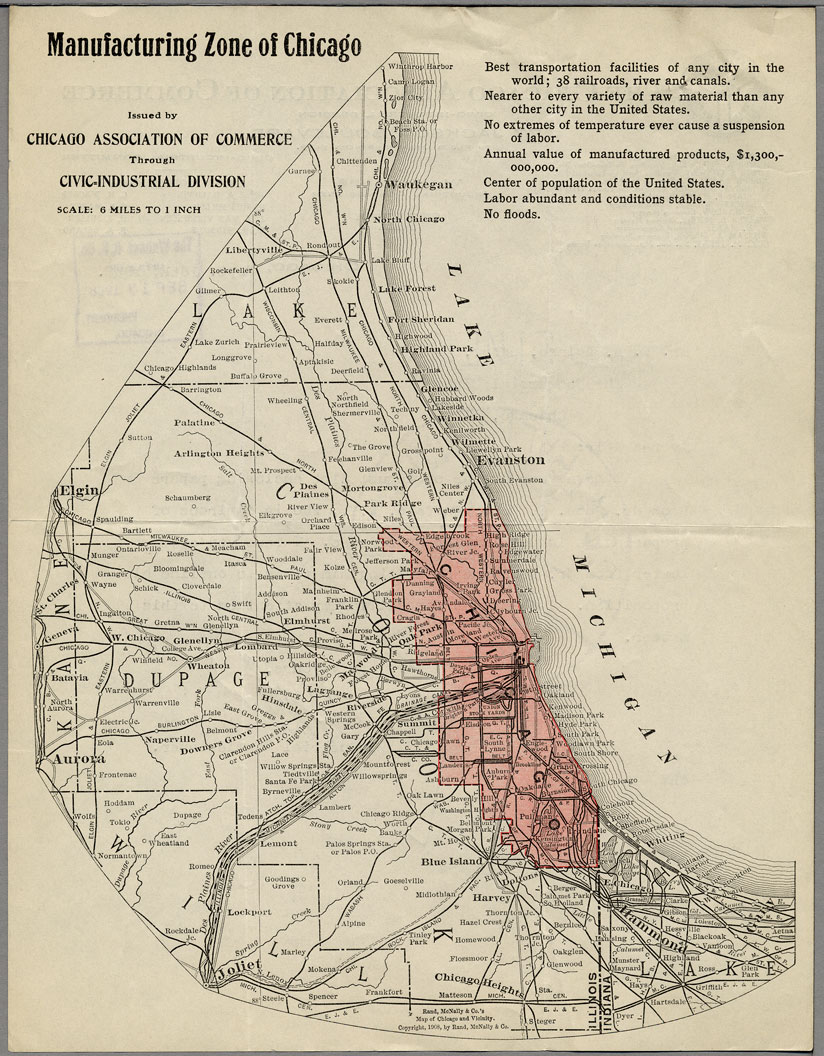 |
TITLE:
DATE:
SUMMARY:
PDF:
|
"Map of the Manufacturing Zone of Chicago"
09/16/1908
This map, printed on the reverse side of the stationery for The Chicago Association of Commerce, shows Chicago's primary manufacturing zone in 1908. Maps and documents of this kind helped the planners take into account the many perspectives on and interests in the city.
DOWNLOAD this document. (1 page)
|
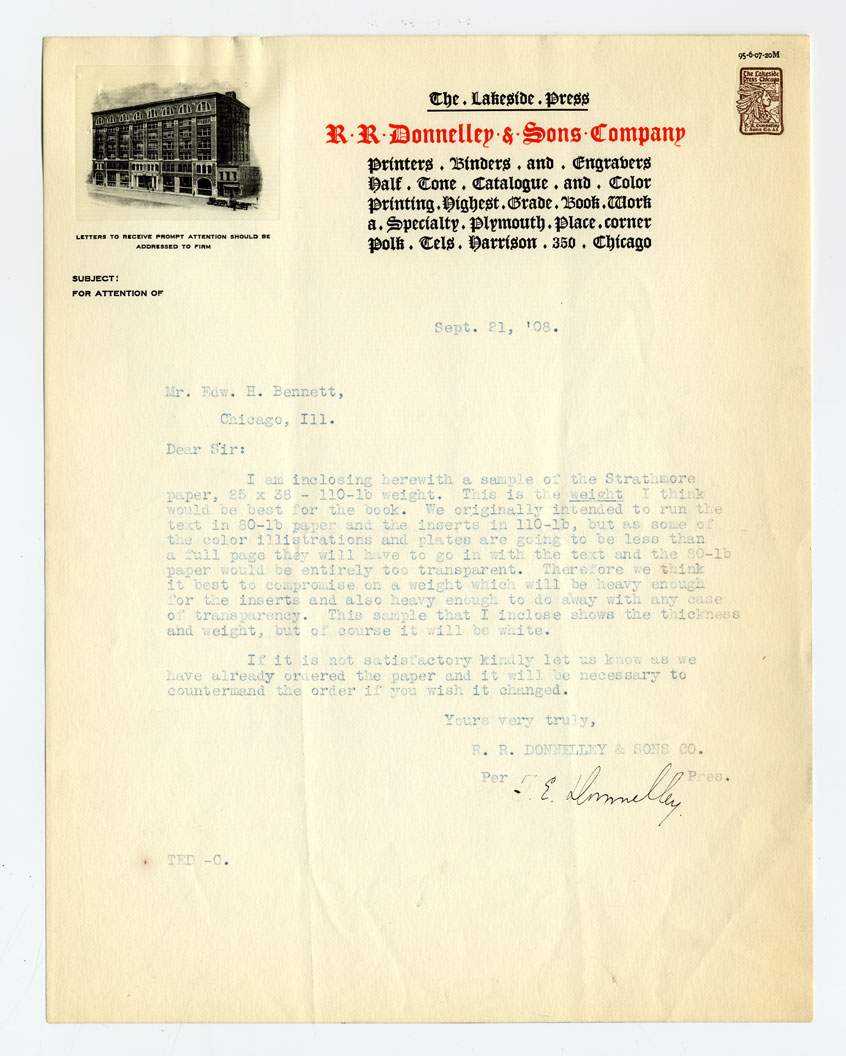 |
TITLE:
DATE:
SUMMARY:
PDF:
|
J.E. Donnelley to Edward H. Bennett
09/21/1908
The planners sought to provide subscribers with an impressive product, in terms of both content and presentation. If the guiding principle of the Plan was the City Beautiful, than that of the text was the "book beautiful," with its sumptuous illustrations and gilded edge. In this letter, the Plan's printer and binder provides Bennett with a sample of the paper, which needed to have sufficient bulk to support the drawings and type.
DOWNLOAD this document. (1 page)
|
 |
TITLE:
DATE:
SUMMARY:
PDF:
|
Commercial Club of Chicago [association], to subscribers of the Plan of Chicago
11/19/1908
The cost of the Plan and the time required to complete it far exceeded the original estimates. This letter of solicitation requests additional subscriptions to the planning effort, so that the committee might reach its goal of an additional $100,000 raised over three years. The names of over three hundred subscribers would be printed in the Plan.
DOWNLOAD this document. (4 pages)
|





